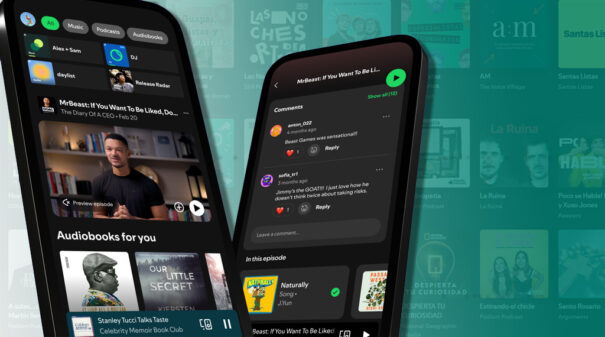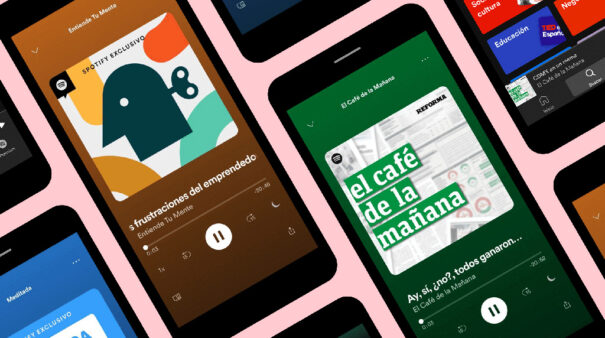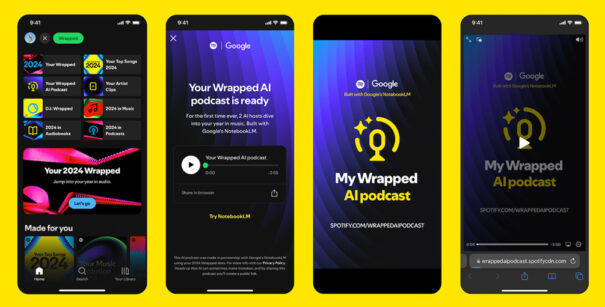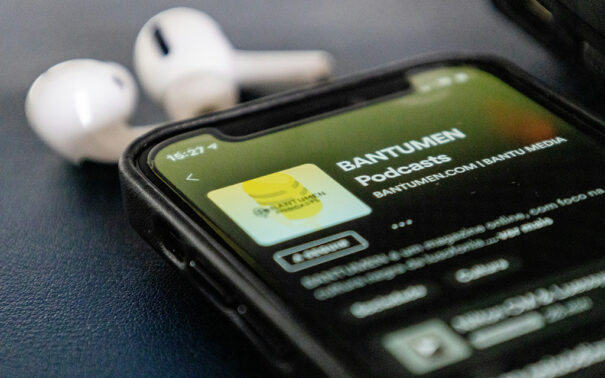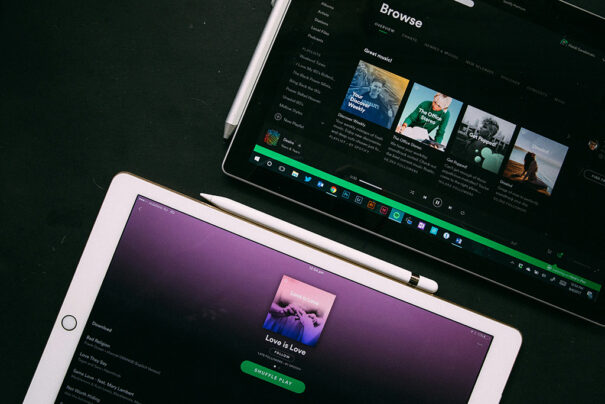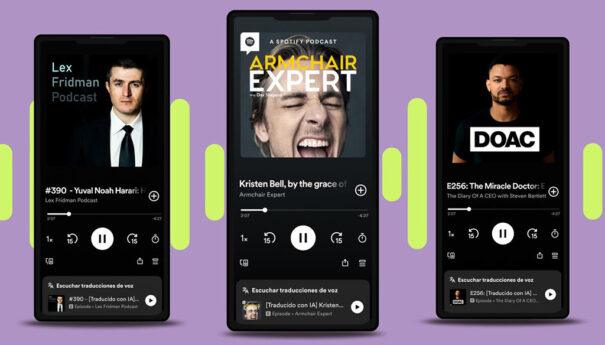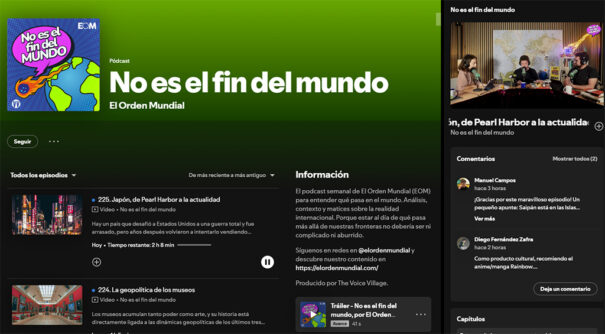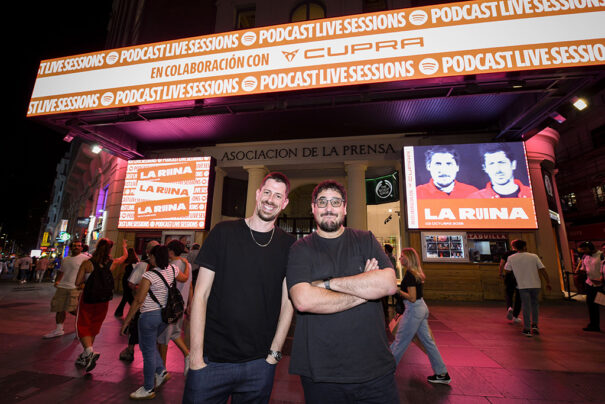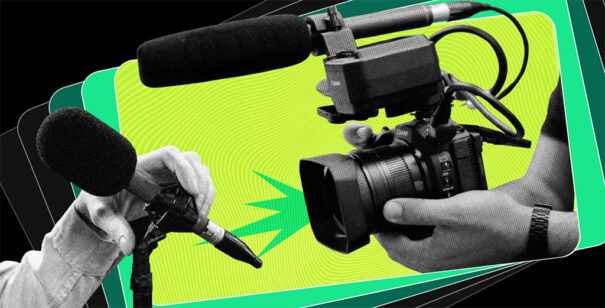El camino de Spotify en los podcasts: de la era de los originales a la revolución del vídeo
Edu Alonso, Head of Podcast para el sur y este de Europa de Spotify, repasa la trayectoria de la plataforma de audio bajo demanda en el terreno de los podcasts y los videopodcasts, áreas en constante redefinición en la que la estrategia de originales ha dejado paso a un enfoque de agregación de contenidos generados por los propios usuarios (UGC).
En el año 2019, Spotify abrió sus puertas a los podcasts. De una forma tímida y apoyándose en contenido limitado, la plataforma musical sueca introdujo en su infraestructura esta nueva tendencia radiofónica, diversificando su negocio y ofreciendo nuevas opciones a sus subscriptores. La eclosión de esta vertiente en España tuvo lugar un año más tarde, cuando la compañía identificó el potencial de reforzar su catálogo con contenidos originales y produjo el memorable XRey, un formato de The Story Lab que introdujo al servicio en la conversación de este nuevo fenómeno sonoro.
En un entorno de sobreestimulación visual, la desconexión a través del audio tenía todo el sentido del mundo. Profundizar en un episodio histórico o descubrir productos culturales bajo demanda mientras se realizaban diferentes tareas supuso toda una revolución en el panorama del audio. Poco a poco, ya sea a través de la fragmentación de formatos radiofónicos o con la creación de contenidos originales, se definió una nueva vertiente industrial del entretenimiento, la cual ha llegado hasta nuestros días convirtiéndose en un fenómeno de masas. En aquellos primeros pasos de Spotify, el servicio contaba con 10 millones de oyentes de podcasts. A día de hoy, supera los 270 millones a nivel global.
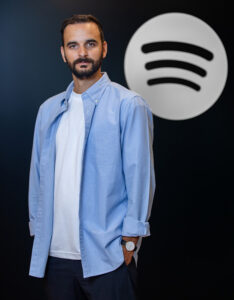 En estos seis años, al igual que otros servicios culturales, el podcast atraviesa una redefinición en contenido y forma. Aquellas píldoras culturales e informativas que marcaron el foco de su primera hornada hispana han dejado paso al fenómeno conversacional; ya no importa tanto la temática, la investigación o su foco, sino las carismáticas personalidades que brindan su propuesta a la industria. El sentimiento de pertenencia a una comunidad se pone en primer plano, y el fenómeno fan subyace en un medio cada vez más visual. El fenómeno del videopodcast acompaña a los principales éxitos del podcast, y las plataformas tecnológicas se adaptan para brindar una propuesta en la que el concepto audio-first deja de ser un axioma del formato.
En estos seis años, al igual que otros servicios culturales, el podcast atraviesa una redefinición en contenido y forma. Aquellas píldoras culturales e informativas que marcaron el foco de su primera hornada hispana han dejado paso al fenómeno conversacional; ya no importa tanto la temática, la investigación o su foco, sino las carismáticas personalidades que brindan su propuesta a la industria. El sentimiento de pertenencia a una comunidad se pone en primer plano, y el fenómeno fan subyace en un medio cada vez más visual. El fenómeno del videopodcast acompaña a los principales éxitos del podcast, y las plataformas tecnológicas se adaptan para brindar una propuesta en la que el concepto audio-first deja de ser un axioma del formato.
Las plataformas de contenido también se adaptan a esta evolución cultural e industrial. De un tiempo a esta parte, Spotify ha decidido dejar en standby el apadrinamiento de podcast originales para consolidarse como agregador de contenido, independientemente de si estos formatos son apoyados por otras plataformas o son generados por los usuarios. La compañía se centra en brindar las herramientas tecnológicas necesarias para su gestión comercial, así como en ofrecer mejoras de UX y en mantener su relevancia entre el público español con diversas iniciativas presenciales e industriales, como su programa Radar, que busca apoyar a los proyectos emergentes nacionales para ayudarlos a consolidar su propuesta.
Edu Alonso, como Head of Podcast para el sur y este de Europa de Spotify, cuenta con una posición privilegiada para identificar la evolución y tendencias del podcast dentro y fuera de la propia plataforma. En este reportaje, arroja todas las claves de un fenómeno que todavía no ha mostrado signos de debilidad en el mercado audiovisual español.
La importancia del podcast para Spotify
Anchor, Gimlet y Megaphone: la llegada de Spotify al terreno del podcast se vio impulsada por la compra de tres gigantes de aquel protomercado del podcasting. La inversión, de más de 550 millones de dólares, permitió a la compañía dar forma a su catálogo y, por encima de todo, mejorar su propuesta tecnológica para alojar este tipo de contenidos. Hoy, uno de cada tres oyentes de Spotify en España escucha podcasts, situando al mercado en la novena posición mundial dentro de la plataforma: “En España, siempre hemos tenido una tradición de entretenimiento. Esto se ha transferido al mundo del podcast: muchísima audiencia ha encontrado un formato con el que conectar con los creadores”.
“Somos un intermediario, una plataforma de conexión; para nosotros, apostar por estas verticales cumple un fin primordial: suplir la necesidad de la gente de formas diferentes de entretenimiento”.
Spotify dio sus primeros pasos en el mercado como una estrategia de diversificación y de “completar una oferta”, un proceso que continúa a día de hoy con el lanzamiento en algunos mercados de audiolibros o la mejora de la calidad del audio. Ahora, estos formatos se han convertido en algo más que un complemento. “El usuario medio de Spotify siempre quiere más. La música a veces no es suficiente, por lo que hemos querido ofrecer una mejor plataforma con una oferta de contenido mucho más diversa”, explica Alonso, quien identifica que esta estrategia va acorde con su naturaleza como empresa “puramente tecnológica”: “Nuestro foco es encontrar soluciones a los problemas que tienen tanto los oyentes como los creadores. Al final, somos un intermediario, una plataforma de conexión; para nosotros, apostar por estas verticales cumple un fin primordial: suplir la necesidad de la gente de formas diferentes de entretenimiento”.
Un presente sin podcast originales
Producido por Toni Garrido y dirigido por Álvaro de Cózar, XRey supuso una gran carta de presentación del potencial de los podcasts en España. Esta cuidada producción, que arrojaba luz sobre episodios concretos de la vida del rey emérito Juan Carlos I, se estrenó en aquel mayo pandémico, momento en el que la población española replanteaba su relación con el entretenimiento. “Fue un experimento, pero que tuvo gran éxito. Bajo mi punto de vista, fue un punto de inflexión en la industria. Se demostró que se podía hacer un narrativo de no ficción en audio y que podía funcionar. Generamos una notoriedad del formato que nadie antes había conseguido, y todo fue gracias a las alianzas con los mejores productos que había en el momento”, recuerda el responsable de Spotify.
A través de los originales, Spotify alcanzó una posición de liderazgo en el terreno de los podcasts, resignificando su rol en el consumo de audio e impulsando un mercado con ideas, pero sin el escaparate adecuado.
El éxito de XRey llevó a Spotify a impulsar una política que se tradujo en el impulso de 50 títulos originales, creando uno de los catálogos más sólidos de audio bajo demanda del momento. La compañía probó todo tipo de géneros, desde el conversacional, que acabaría consolidándose como tendencia estatal, hasta el documental: “El nombre de Spotify estuvo asociado a los ganadores de los Premios Ondas durante varios años consecutivos. Primero, con XRey; después, con un Deforme Semanal que también era exclusivo de Spotify, y también fue condecorado Misterio en la Moraleja, otro narrativo de 2022”.
A través de los originales, Spotify alcanzó una posición de liderazgo en el terreno de los podcasts, resignificando su rol en el consumo de audio e impulsando un mercado con ideas, pero sin el escaparate adecuado para trasladarlas sin un apoyo directo de marcas o sin las plataformas asociadas a la radio tradicional, que poco a poco construyeron un complemento sólido a su oferta lineal. No obstante, como explica Alonso, “la industria ha cambiado”.
Los originales ya no forman parte de la estrategia de Spotify: “En el año 2020, era una necesidad imperiosa la de producir más contenido y ayudar a impulsar la industria, pero tenía ciertas limitaciones, ya que no podíamos apoyar a más de 10 o 15 títulos al año. A la par, también había ciertas limitaciones asociadas a la distribución de la IP y los derivados. Por eso, decidimos virar este modelo al actual”.
La estrategia UGC de Spotify
Spotify todavía mantiene el sello “original” en su catálogo histórico y, este año, el concepto de exclusividad sobrevive con un único título: el podcast de la doctora Marian Rojas Estapé. “No cerramos la puerta por completo a la producción de más contenido original, pero donde estamos poniendo más el foco es en la otra parte: la de ser plataforma”, comenta Alonso.
“No cerramos la puerta por completo a la producción de más contenido original, pero donde estamos poniendo más el foco es en la otra parte: la de ser plataforma”.
En la actualidad, Spotify se está centrando en el desarrollo de herramientas para, a través de la monetización, la distribución y la creación de audiencias, ayudar a creadores y partners a gestionar y poner a disposición contenido en la plataforma, brindando soluciones para que tengan alcance y retorno. Esta decisión parte de la naturaleza freemium de la plataforma, que hace que en los 180 mercados en los que opera el servicio de audio se sumen más de 600 millones de usuarios, pero también en la consolidación de la industria y el “desbloqueo” de su mercado publicitario, que ya cuenta con productoras especializadas y una base de marcas que apoyan los podcasts vía patrocinios, branded, anuncios o product placement, entre otras vías.
Actualmente en Spotify son los propios podcasters y productoras los que tienen un control total sobre su IP y pueden decidir cómo y dónde distribuirla. Para ello, la tecnológica pone a la disposición del mercado plataformas como Megaphone o Spotify for Creators, pero también desarrolla integraciones cruzadas con servicios como Patreon, para que los usuarios puedan desbloquear contenido exclusivo: “Al final, lo que estamos tratando es ofrecer muchas más herramientas y libertad a los creadores”.
El cajón de sastre de los podcasts
Esta decisión por parte de Spotify no está exenta de riesgos. Al igual que otras plataformas abiertas del mercado, el usuario tiene a su disposición un océano de podcasts entre los que escoger. No hay criterio editorial que rija el catálogo, sino puertas abiertas para que los usuarios suban su contenido siempre que respete los límites habituales en materia de copyright y contenido: “Somos una plataforma UGC, user generated content, que permite a cualquiera que respete las normas subir su podcast. Si tú decides charlar con tu primo cinco minutos y subirlo, eres libre de hacerlo. No queremos tener un rol de gatekeepers, controlando quién entra y quién no”.
“Somos una plataforma UGC, user generated content, que permite a cualquiera que respete las normas subir su podcast. Si tú decides charlar con tu primo cinco minutos y subirlo, eres libre de hacerlo”.
Esta filosofía provoca que el catálogo de Spotify, como tantas otras plataformas abiertas, se encuentre fragmentado. Es frecuente ver temporadas incompletas, proyectos abandonados o podcast sin sus entregas más recientes, las cuales siguen publicándose en otros servicios de audio. Para atajar esta situación, el equipo de Spotify confía en la curaduría editorial y en herramientas tecnológicas para guiar al oyente en su experiencia de escucha: “En este punto, tenemos que identificar indicadores de relevancia. Para ello, analizamos el comportamiento de la audiencia, contamos con un equipo editorial humano y desplegamos herramientas más tecnológicas o algorítmicas basadas en machine learning o inteligencia artificial (…) Estamos lejos de ser perfectos, pero trabajamos constantemente en mejorar la plataforma y entender mejor a nuestros usuarios”.
La IA llega al podcast
La generación de voz sintética y su utilización para piezas audiovisuales se ha normalizado en la generación de contenido dirigido a redes sociales, lo que podría abrir sus puertas a otro tipo de contenidos como los podcasts. En España, ya se han dado los primeros ejemplos de piezas creadas íntegramente por este tipo de soluciones. La agencia creativa Prodigioso Volcán fue pionera en 2022 con Relatos sintéticos, un formato que empleó herramientas de IA generativa utilizando Chat GPT y modelos de texto a voz, mientras que en 2023 la NPR estadounidense hizo lo propio produciendo un episodio del formato Planet Money con herramientas de clonación de voz.
“No tenemos nada en contra de la IA. Al contrario: hay que abrazar el cambio y entender cómo nos puede ayudar en la parte más creativa y en la operativa”.
En apenas tres años, las herramientas de generación de contenido basadas en IA han evolucionado considerablemente. Por ahora, Spotify no cuenta con una política para poner cotos a este tipo de contenido, que a buen seguro podrá ocupar un papel de relevancia en las preferencias de consumo de los espectadores. Es una tendencia, en definitiva, pendiente de consolidarse: “A día de hoy, no conocemos ningún podcast que haya generado un impacto a nivel internacional que utilice este tipo de tecnologías”.
Alonso, por el contrario, es consciente de que en la actualidad se están desplegando soluciones específicas de IA para apoyar la producción de podcasts: “No tenemos nada en contra de la IA. Al contrario: hay que abrazar el cambio y entender cómo nos puede ayudar en la parte más creativa y en la operativa”. Uno de esos posibles usos puede ser la traducción de formatos, un proceso que ya se utiliza en la industria del doblaje y que permite mantener el timbre y tono original del locutor: “Son proyectos bastante interesantes. Al final, la idea es valerte de herramientas tecnológicas para acceder a nuevos mercados. Siempre que no supongan infracción de copyright o impacten de alguna forma sobre algún derecho, será algo que abrazaremos”.
El videopodcast: un fenómeno imparable
La segunda revolución de la industria de los podcasts ha venido acompañada del vídeo. Contradiciendo aquellos pilares que permitieron al formato consolidarse entre las preferencias de los oyentes, aquellos conceptos de background content o la desconexión visual, esta nueva tendencia se refleja en los formatos más exitosos de la plataforma: nueve de los diez formatos más escuchados en España se valen de un apoyo visual integrado directamente en Spotify.
“La premisa inicial era una estrategia audio first. Considerábamos que el vídeo tenía que ser un complemento, y que, si se quitaba, el contenido tenía que seguir funcionando. La realidad nos ha dado un poco en la cara. Al final, los creadores y los oyentes deciden cómo usar el vídeo y cuál es su experiencia”, comenta Alonso, consciente de la imprevisibilidad de los hábitos de consumo de sus propios usuarios.
“La premisa inicial era una estrategia audio first. Considerábamos que el vídeo tenía que ser un complemento, y que, si se quitaba, el contenido tenía que seguir funcionando. La realidad nos ha dado un poco en la cara. Al final, los creadores y los oyentes deciden cómo usar el vídeo y cuál es su experiencia”.
Según un estudio conducido por la plataforma en Estados Unidos, el 64% de los usuarios prefiere tener vídeo acompañando sus podcasts. Y lo que es más sorprendente: el 70% de los usuarios que consumen videopodcasts deciden ver el vídeo en primer plano, ya sea en el móvil o en la televisión.
Con 330.000 podcasts con vídeo su catálogo (todos ellos en resolución Full HD), y un 20% de creadores españoles que optan por esta opción, el cambio de tendencia es una realidad. Hasta que se consolide y se estandarice el videopodcast como estándar del podcasting, Spotify trabaja por integrar ambas vertientes para mejorar la experiencia de consumo de cada usuario: “Lo ideal es este “Elige tu propia aventura” en el que el consumidor pueda migrar entre las dos experiencias sin costuras. Puedes ir en el autobús viendo el podcast, pero, cuando sea tu parada, podrás meter el móvil en el bolsillo y seguir escuchándolo sin interrupciones”.
Podcasts y fenómeno fan
Los podcasts, sean visuales o tradicionales, encuentran gran parte de su éxito en la interrelación entre el talento y su audiencia. El auge de los podcasts conversacionales y el doble rol de sus conductores como influencers ha transformado la gestión de sus comunidades, pasando del enfoque radiofónico para acercarlo al terreno de los artistas musicales. El fenómeno fan y el sentimiento de pertenencia actúan como motores de una industria que encuentra grandes oportunidades en las redes, pero también en los eventos presenciales.
“El público está deseando consumir contenido y entrar en comunión con sus creadores favoritos. Existe un fenómeno fan dentro del podcast que, obviamente, tenemos que reflejar en nuestra estrategia”.
Cada vez es más habitual que las grabaciones de determinados formatos, las cuales frecuentemente se realizan ante una audiencia reducida, multipliquen su apuesta para reunir a sus comunidades en teatros o auditorios. Spotify se ha sumado a esta tendencia con sus Spotify Podcast Live Sessions, un evento de podcasts en directo que llenó el Palacio de la Prensa de Madrid con cuatro de los videopodcasts de comedia más exitosos: La Ruina, Poco se habla, Arde Venecia y Reyes del Palique. “Ofrecimos la posibilidad a los mayores fans de estos shows de asistir a una grabación en directo. La gente vino superentregada a la experiencia. Nos demuestra que el público está deseando consumir contenido y entrar en comunión con sus creadores favoritos. Existe un fenómeno fan dentro del podcast que, obviamente, tenemos que reflejar en nuestra estrategia”, traslada Alonso.
Esta interacción podría trasladarse en el futuro al ecosistema tecnológico de la plataforma. Más allá de la ya establecida interacción a través de comentarios, Spotify podría llegar a implementar algunas de las herramientas asociadas al mundo musical, como la venta directa de entradas en la plataforma o de merchandising: “Creo que no tardará mucho en llegar”.
Las oportunidades presentes y futuras del podcast
La capacidad de anticiparse a dos tendencias consolidadas como son los podcasts y los videopodcasts ratifica la validez de la estrategia de Spotify. La compañía, apoyándose en la innovación y la inversión en la tecnología, trabaja activamente para seguir los hábitos de consumo de los oyentes y atender a las necesidades de la comunidad creativa. “También estamos inmersos en la revolución de la IA. No sabemos muy bien hacia dónde nos va a llevar, pero ya estamos haciendo diferentes pilotos para validar herramientas internamente”, explica Alonso.
“Ceñirnos a la estricta definición de lo que es un podcast y lo que no, no ayuda. (…). Debemos ser transversales. Al final, nuestra función es conectar a una audiencia con un creador”.
A nivel de contenido, el responsable del área de podcasts de Spotify detecta oportunidades que “no se están aprovechando” en terrenos como la educación, el mundo infantil o la oferta fitness: “Hay diferentes categorías de contenido en las que veo una oportunidad, pero nosotros no seremos los encargados de hacerlo solos. Tiene que haber una necesidad por parte de los espectadores y un compromiso por parte de los creadores”.
En paralelo, Alonso identifica un “gran margen de expansión” en diferentes líneas que permitirán que el videopodcast “crezca en diferentes ángulos”. Para conseguirlo, será necesario, una vez más, redefinir el concepto mismo de podcast. Es la decisión más coherente en una industria en la que los hábitos de consumo, y los propios formatos, evolucionan para captar la atención del siempre voraz e inconformista consumidor de contenido: “Ceñirnos a la estricta definición de lo que es un podcast y lo que no, no ayuda. Tenemos que entender, como plataforma, cómo podemos dar un mejor servicio a creadores y oyentes, más allá de que lo que distribuyamos sea una ficción, un documental, un videopodcast, un conversacional, un vídeo de fitness o una sesión de yoga. Debemos ser transversales. Al final, nuestra función es conectar a una audiencia con un creador”.
Un reportaje de Sergio Julián Gómez
¿Te gustó este artículo?
Suscríbete a nuestro NEWSLETTER y no te perderás nada.



